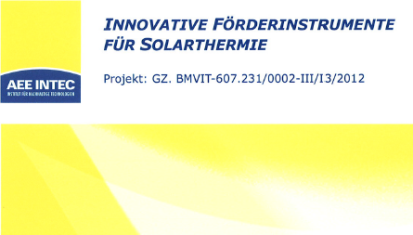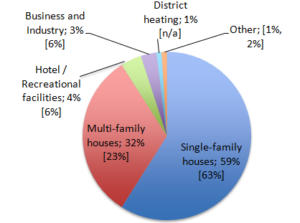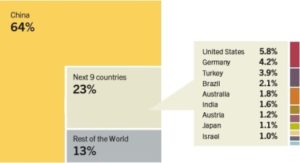Austria: Search for Innovative Incentive Schemes
May 7, 2014
Austria has a leading position in solar energy use worldwide. 3.5 GWth (5 million m²) of solar thermal capacity had been installed in total until the end of 2012. Based on the specific collector area per inhabitant, Austria ranks third after Cyprus and Israel. The key factor for the country’s success has been the mix of incentive and R&D programmes, as well as awareness-raising campaigns since the mid-1980s. In one area, however, these measures have not succeeded: The system prices for the end consumer have remained unchanged and have not followed the cost reduction curve of the photovoltaic sector. This is why the Austrian Ministry for Transport, Innovation and Technology (bmvit) had mandated AEE Intec, the Austrian Institute for Sustainable Technologies, to carry out a stakeholder survey in order to develop innovative incentive instruments which could give fresh impetus to increases in price performance ratios of solar thermal systems of all sizes.
AEE Intec has now published a 96-page study (in German, see the attached pdf) describing the available support instruments at national and global level and analysing new approaches towards increasing the price performance ratio of the residential and commercial solar heating and cooling market. Chapter 5 examines the efficiency of support schemes in terms of stimulating market growth, producing technology innovations and having an impact on retail prices.
Checklist for designing a successful support scheme
Chapter 6, “Incentive schemes worldwide”, was contributed by solrico, the network of solar thermal specialists in charge of the news section of solarthermalworld.org. The overview, which is based on five years of research for the website’s database of incentive programmes, lists the pros and cons and explains best practice examples of seven different types of demand-side support schemes: direct capital subsidies, performance-based incentives, low-interest loans, VAT reductions, Renewable Energy Certificates, Clean Development Mechanisms and Energy Service Companies.
The attached presentation summarises the content of Chapter 6 in English and includes the three-slide checklist “How to design a successful support scheme?” (p. 44 to 46): The first slide shows the 12 universally applicable lessons learned, whereas the second one should be applied when programmes aim at private homeowners. The third one includes the points which are important when targeting commercial customers.
Subsidy level depends on solar yield and heat generation costs
Chapter 8 is the key part of the study in terms of designing new innovative support schemes. The authors from AEE Intec chose two advanced support measures – one for the residential and one for the commercial sector (see below).
Residential customers should have their subsidy level linked to the solar share of the energy demand, as well as to the heat generation costs over the system’s economic lifetime. Both factors can be calculated based on the data which has already been submitted with applications for Austria’s regional programmes. The factors should influence the amount of subsidy that the client receives. A larger solar share and lower heat generation costs should result in a higher subsidy amount. Calculation examples are given on pages 60 to 65 of the attached study.
Regarding the commercial sector, the authors suggest a solar heat tariff which should apply for installations above 50 m2, at which point heat metering is reasonable. To make investors, such as hotels or industrial companies, interested in solar heat, the rate of return of the investment should be at least 6 % calculated with the Net Present Value Method (see the following table with two case studies).
| Collector area |
System costs |
Solar yield |
Economic lifetime |
Return rate without subsidy |
Heat tariff paid over 15 years to reach 6 % rate of return |
| 250 m² | 680EUR/m² | 400 kWh/m²a | 25 years | 0.2 % | 53.3 EUR/MWh |
| 1,000 m² | 480 EUR/m² | 420 kWh/m²a | 25 years | 1.7 % | 26.2 EUR/MWh |
Source: AEE Intec
This model is based on a guaranteed positive rate of return for the investor. If the investor’s system costs turn out to be lower than planned or the solar yield is larger than predicted, they can achieve even higher rates of return than 6 %. Therefore, this scheme clearly leads to reliable and high-quality systems.
More information:


